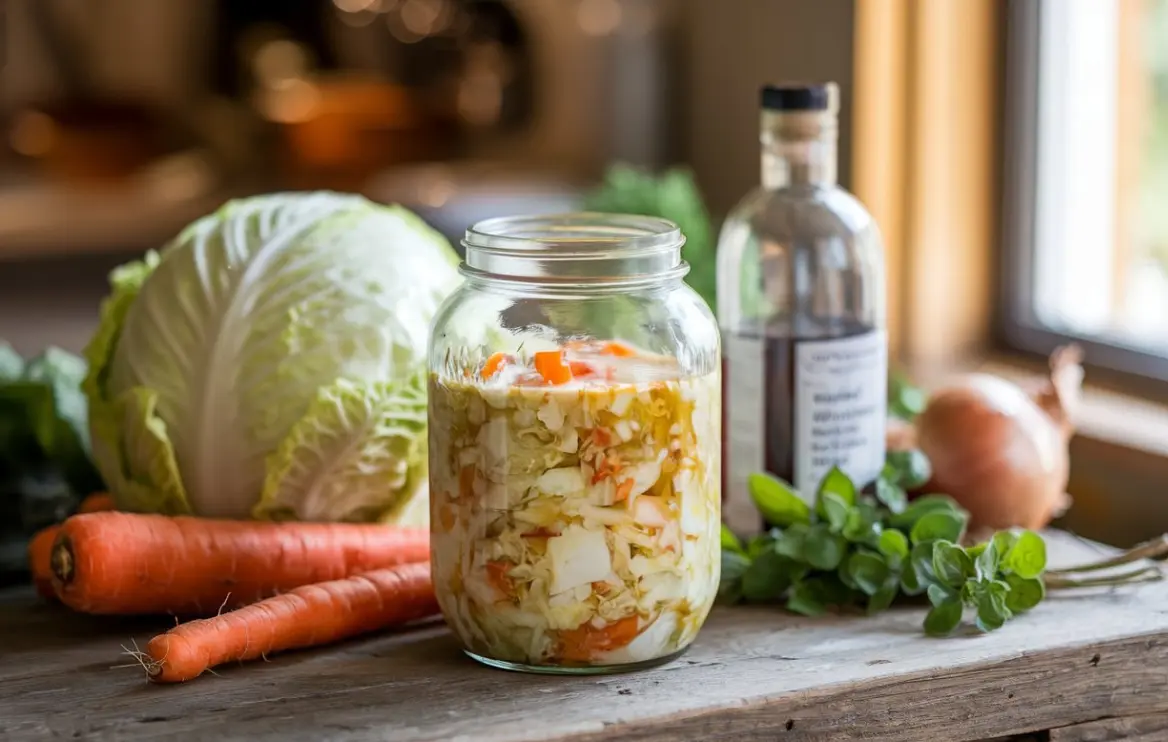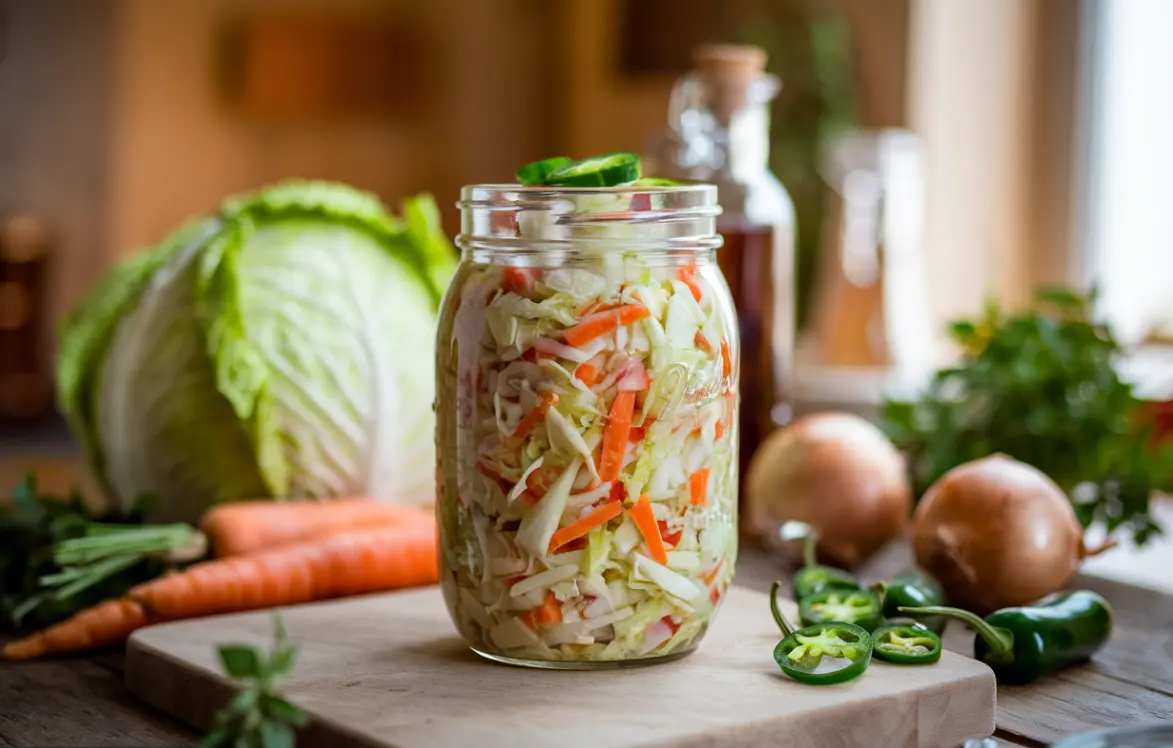Curtido Recipe: A Traditional Salvadoran Slaw is a vibrant, tangy slaw that is a staple in Salvadoran cuisine. Similar to sauerkraut or kimchi, it’s a fermented cabbage relish that adds a refreshing contrast to rich, hearty dishes. Curtido Recipe: A Traditional Salvadoran Slaw is most commonly served alongside pupusas, a Salvadoran corn cake filled with cheese, beans, or meat, but its versatility makes it a perfect accompaniment to many dishes.
In this comprehensive guide, you’ll learn how to make curtido from scratch, the benefits of fermentation, and how to use this flavorful slaw in your meals. By the end of this article, you’ll be equipped with all the knowledge you need to create an authentic curtido that rivals the best Salvadoran kitchens.
Ingredients for Authentic Curtido Recipe
Curtido Recipe is made from a handful of simple, fresh ingredients, most of which you probably already have in your kitchen:
- Cabbage: Green cabbage is the most traditional choice, but for a colorful twist, you can mix in red cabbage.
- Carrots: These add a natural sweetness and a bit of crunch.
- Onion: Both red and white onions work well, providing a sharp flavor that balances the tanginess.
- Oregano: Dried Mexican oregano is ideal due to its robust flavor, but if you can’t find it, regular oregano will suffice.
- Vinegar: White vinegar is traditional, but apple cider vinegar can be used for a slightly sweeter flavor profile.
- Salt: Essential for drawing out moisture from the cabbage and initiating the fermentation process.
- Optional Ingredients: Jalapeños or other hot peppers for heat, and radishes or beets for additional flavor and color.
Preparing the Vegetables
- Shredding and Slicing:
- Start by finely shredding the cabbage and carrots. The finer the shred, the better the texture of your curtido Recipe.
- Thinly slice the onions to ensure they blend well with the cabbage and carrots.
- Adding Optional Ingredients:
- If you’re using jalapeños, slice them thinly. You can remove the seeds if you prefer a milder curtido Recipe. Adding radishes or beets will not only enhance the color but also contribute additional layers of flavor.
Mixing the Ingredients
Once your vegetables are prepped, it’s time to bring everything together:
- Combining the Vegetables:
- In a large mixing bowl, combine the shredded cabbage, carrots, onions, and any optional ingredients you’ve chosen. Make sure everything is evenly distributed.
- Seasoning:
- Sprinkle the salt and oregano over the vegetables. The salt will help draw out the moisture from the cabbage, which is crucial for the fermentation process.
- Massaging the Vegetables:
- Use your hands to massage the salt and oregano into the vegetables. This process not only mixes the seasoning but also helps to break down the cabbage, releasing its natural juices and beginning the fermentation process.
Packing the Jar
- Selecting a Jar:
- A wide-mouth jar is the most suitable, as it enables you to compact the vegetables with ease. Select a spotless glass jar with a tight-fitting lid.
- Filling the Jar:
- Begin transferring the vegetable mixture into the jar, pressing down firmly with each addition to remove air pockets. This compacting process is essential for proper fermentation.
- Adding the Vinegar:
- Pour the vinegar over the packed vegetables. The vinegar should cover the vegetables completely. If there isn’t enough liquid, you can top it off with a bit of water. Make sure to leave about an inch of space at the top of the jar to allow for expansion during fermentation.

Fermentation Process
- Initial Fermentation:
- Cover the jar loosely with a lid or cloth and place it in a warm, dark area. Let it sit at room temperature for 2-3 days. During this time, the beneficial bacteria will begin to ferment the vegetables, creating the characteristic tangy flavor of curtido.
- Monitoring and Tasting:
- Taste the curtido after 2 days. If it’s tangy enough for your liking, you can move it to the refrigerator to slow down the fermentation process. If not, let it ferment for another day or two.
- Refrigeration:
- Once the curtido has reached your desired level of tanginess, tighten the lid and store it in the refrigerator. It can be kept for several weeks, and the flavor will continue to develop over time.
Serving Suggestions
Curtido Recipe is a versatile condiment that can enhance a variety of dishes. Here are some suggestions for applications of it:
- As a Side Dish:
- Serve curtido with pupusas, tamales, or tacos to add a refreshing crunch and tang.
- On Sandwiches:
- Use curtido as a zesty topping for sandwiches, burgers, or tortas.
- In Salads:
- Mix curtido into green salads or grain bowls to add texture and a burst of flavor.
- With Grilled Meats:
- The acidity of curtido cuts through the richness of grilled or roasted meats, making it a perfect accompaniment to dishes like birria tacos or pork cutlets.
- On Pizza:
- For a unique twist, try adding curtido to your pizza as a topping. It pairs especially well with spicy or meaty pizzas like chimichurri tomato pizza.
Health Benefits of Curtido
Incorporating fermented foods like curtido into your diet can provide numerous health benefits:
- Probiotics for Gut Health:
- The fermentation process produces probiotics, beneficial bacteria that support a healthy digestive system. These probiotics can improve gut health, boost immunity, and even enhance mood.
- Rich in Vitamins and Minerals:
- Curtido is a great source of vitamins C and K, thanks to the cabbage. Carrots add beta-carotene, which is converted into vitamin A in the body. These nutrients are essential for maintaining healthy skin, immune function, and bone health.
- Low in Calories, High in Fiber:
- Curtido is a low-calorie, high-fiber food, making it a great addition to a balanced diet. The fiber content helps enhance fullness and improves digestive health.
Customizing Your Curtido
One of the best things about curtido is how easily it can be customized to suit your taste preferences. Here are some ideas to personalize your curtido:
- Adjusting the Tanginess:
- If you prefer a milder curtido, reduce the fermentation time or add a small amount of sugar to balance the acidity.
- Adding Heat:
- For those who love a spicy kick, increase the amount of jalapeños or add a few dashes of hot sauce. You could also experiment with other types of peppers, such as habaneros, for an extra fiery curtido.
- Exploring Different Vinegars:
- While white vinegar is traditional, using apple cider vinegar or even rice vinegar can change the flavor profile of your curtido, giving it a sweeter or more subtle tang.
- Including Additional Vegetables:
- Don’t be afraid to add other vegetables to your curtido. Radishes, beets, or even shredded jicama can add new flavors and textures. Just be sure to maintain the balance between the cabbage and other ingredients to ensure proper fermentation.

Curtido Recipe in Global Cuisine
Although curtido is a Salvadoran staple, its concept of fermented vegetables can be found in many global cuisines. Understanding these similarities can give you more ideas for incorporating curtido into your meals:
- Curtido vs. Kimchi:
- Like kimchi in Korean cuisine, curtido is a fermented vegetable dish that provides a tangy, crunchy complement to rich foods. While kimchi is often spicy and includes ingredients like garlic and ginger, curtido is typically milder with a focus on cabbage, carrots, and oregano.
- Curtido vs. Sauerkraut:
- Curtido is similar to sauerkraut, a German fermented cabbage dish. However, sauerkraut is usually simpler, made with just cabbage and salt, and it has a much longer fermentation time. Curtido’s shorter fermentation and additional ingredients like carrots and onions give it a more complex flavor profile.
- Curtido in Latin American Cuisine:
- Throughout Latin America, variations of curtido can be found. In Mexico, for example, a similar slaw called escabeche is made with pickled vegetables like carrots, onions, and jalapeños. These regional variations highlight the versatility of fermented vegetable dishes across different culinary traditions.
Curtido in Your Everyday Meals
Incorporating curtido into your daily meals is easy and can elevate your dishes to new heights. Here are some practical ideas:
- Breakfast:
- Add curtido to your morning eggs or breakfast burritos for a tangy, crunchy start to your day. It pairs especially well with scrambled eggs, adding both flavor and texture.
- Lunch:
- Use curtido as a topping for grain bowls or salads. It adds a burst of flavor without the need for heavy dressings, keeping your lunch light and healthy.
- Dinner:
- Serve curtido as a side with grilled meats or roasted vegetables. Its acidity cuts through the richness of dishes like roast pork or barbecue chicken, balancing the meal and adding depth of flavor.
- Snacks:
- Enjoy curtido on its own as a crunchy, tangy snack. It’s also great paired with crackers and cheese for a simple, yet satisfying treat.
Curtido: A Versatile and Nutritious Addition
Curtido is more than just a condiment; it’s a versatile, nutritious addition to your culinary repertoire. Its bright, tangy flavor enhances a wide range of dishes, while its fermentation process offers health benefits that can improve your overall well-being. Whether you’re looking to explore Salvadoran cuisine or simply add more probiotics to your diet, curtido is a delicious and easy way to achieve your goals.
Further Reading and Recipes
To continue your culinary journey, explore these related recipes and articles that pair well with curtido:
- Ultimate Rotisserie Chicken Recipes: Learn how to make the most of rotisserie chicken, with curtido as a perfect side dish.
- The Ultimate Guide to Baked Beans: Another classic side that pairs wonderfully with curtido, especially at a barbecue.
- Ooni Pizza Dough Recipe: Try curtido as a unique pizza topping using this simple and delicious pizza dough recipe.
Conclusion
Making curtido at home is a rewarding experience that brings the vibrant flavors of Salvadoran cuisine into your kitchen. With this guide, you now have all the tools you need to create an authentic and delicious curtido that can be customized to suit your taste. Whether you enjoy it as a side dish, a topping, or a standalone snack, curtido is sure to become a staple in your culinary adventures.
By following the steps outlined above and experimenting with different ingredients and flavors, you’ll master the art of making curtido and discover new ways to enjoy this versatile slaw. Don’t forget to explore the other related recipes on the Ollie Recipes website to complement your curtido and create a full, flavorful meal.

